Key takeaways:
- Video lighting significantly impacts mood and storytelling, with techniques like three-point lighting enhancing depth and dimension.
- Choosing high-quality, versatile, and portable lighting equipment is crucial for effective production, as it directly influences scene quality and viewer perception.
- Understanding color temperature and experimenting with practical lights can greatly enhance the authenticity and emotional resonance of a scene.
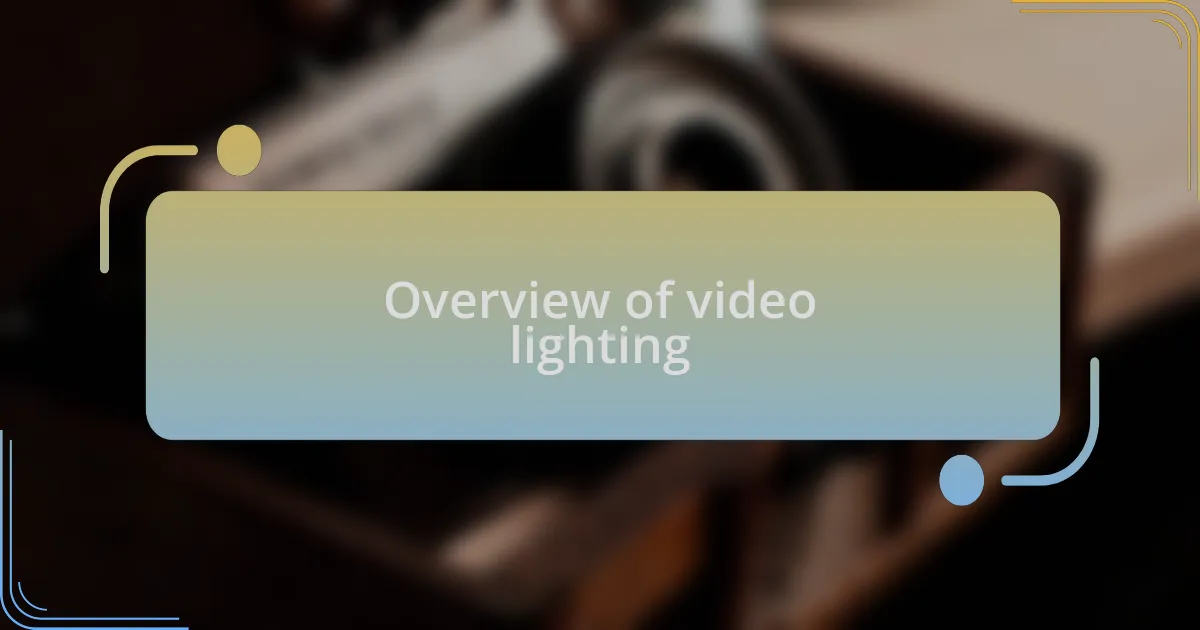
Overview of video lighting
Video lighting is one of the most critical aspects of film production, profoundly influencing how a scene is perceived. I recall the first time I shot a short film and relied solely on natural light. The results were uneven and disappointing, which taught me that mastering artificial lighting can completely transform the mood and quality of a project.
When I think about lighting, it’s not just about visibility; it’s about creating an atmosphere. For example, using warm tones can evoke feelings of nostalgia or comfort, while cooler tones might generate tension or a sense of urgency. Have you ever paused to consider how a simple shift in color temperature can change the entire narrative of a scene? It’s fascinating how carefully orchestrated lighting can elevate storytelling.
Moreover, understanding the three-point lighting technique was a game changer for me. It combines key, fill, and backlighting to provide depth and dimension to a subject. I remember a time when I experimented with this setup during a portrait shoot. The difference was night and day, leaving me and my audience in awe of the transformation. Exploring video lighting isn’t just about technical knowledge; it’s an opportunity to express creativity and evoke emotion in your audience.
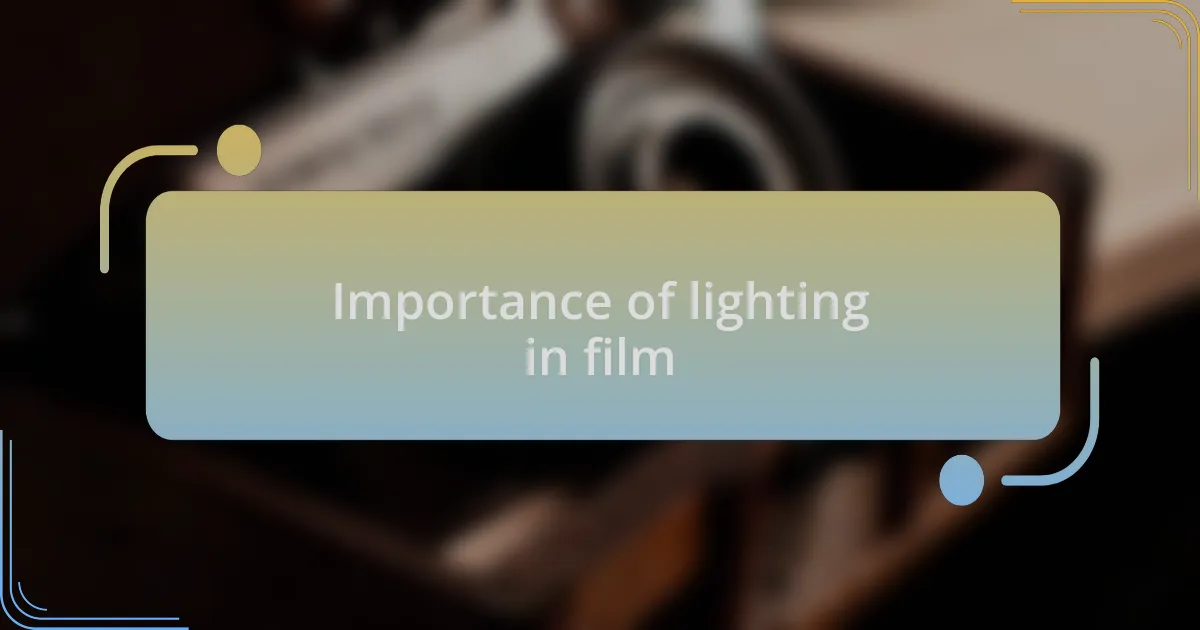
Importance of lighting in film
Lighting is essential in film because it shapes how viewers perceive every aspect of a scene. I vividly remember a crucial moment while filming a dramatic scene where I underestimated the power of shadows. Once I adjusted the lights to create stark contrasts, the entire mood changed, immersing the audience in the character’s internal struggle. Isn’t it incredible how a single lighting adjustment can enhance a narrative?
The importance of lighting also lies in its ability to guide the viewer’s focus. I learned this lesson during a project where brights spots drew attention to the main character’s emotional moment, while dimmer areas crafted an air of mystery around the setting. Have you ever noticed how certain films use lighting to lead your eye exactly where it needs to be? It’s like a silent guide within the story, deeply influencing the audience’s experience.
Furthermore, good lighting can reveal character motivation in subtle yet impactful ways. One time, I lit a scene using harsh overhead light to showcase a character’s isolation. The starkness not only conveyed their emotional state but also added layers to the storytelling, inviting the viewer to empathize with their plight. Lighting isn’t just a technical aspect; it’s a silent storyteller, shaping the film’s emotional landscape and connection to the audience.
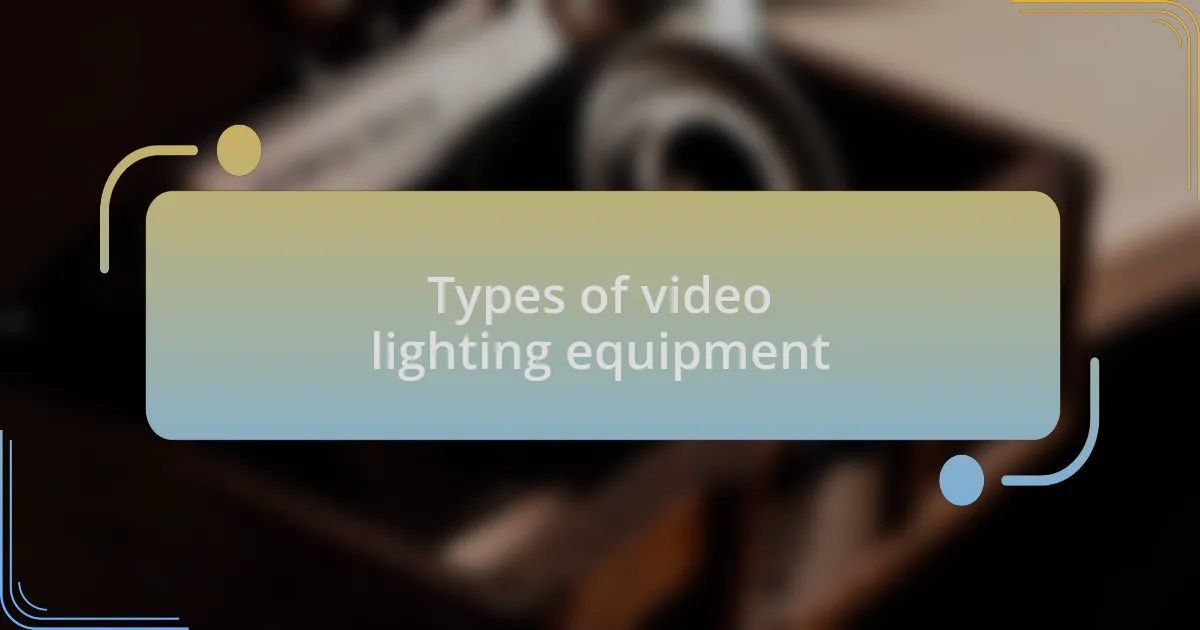
Types of video lighting equipment
When it comes to video lighting equipment, there are several types that can dramatically transform your production. I often rely on key lights, which are essential for illuminating the subject’s face and creating depth in the shot. I remember being impressed during one shoot when a simple adjustment of the key light changed a flat image into one that truly popped, enhancing the emotional resonance of the scene.
Softboxes and LED panels also hold a special place in my toolkit. The softbox diffuses light, creating a gentle and flattering glow that makes skin tones look natural. Once, I experimented with an LED panel for an interview setup, and I was surprised at how efficiently I could control the intensity and color temperature, crafting just the right atmosphere. Isn’t it fascinating how subtle changes in lighting can drastically change the tone of an interview?
On the other hand, I’ve come to appreciate the versatility of backlights, which add separation and dimension to the scene. They can create a beautiful rim light that outlines the subject and brings them to life, enhancing their presence on screen. I recall filming a storytelling segment where using a backlight created a magical halo effect that perfectly underscored the story’s whimsical nature. It’s a small detail, but it’s moments like these that make the difference between a good shot and a great one.
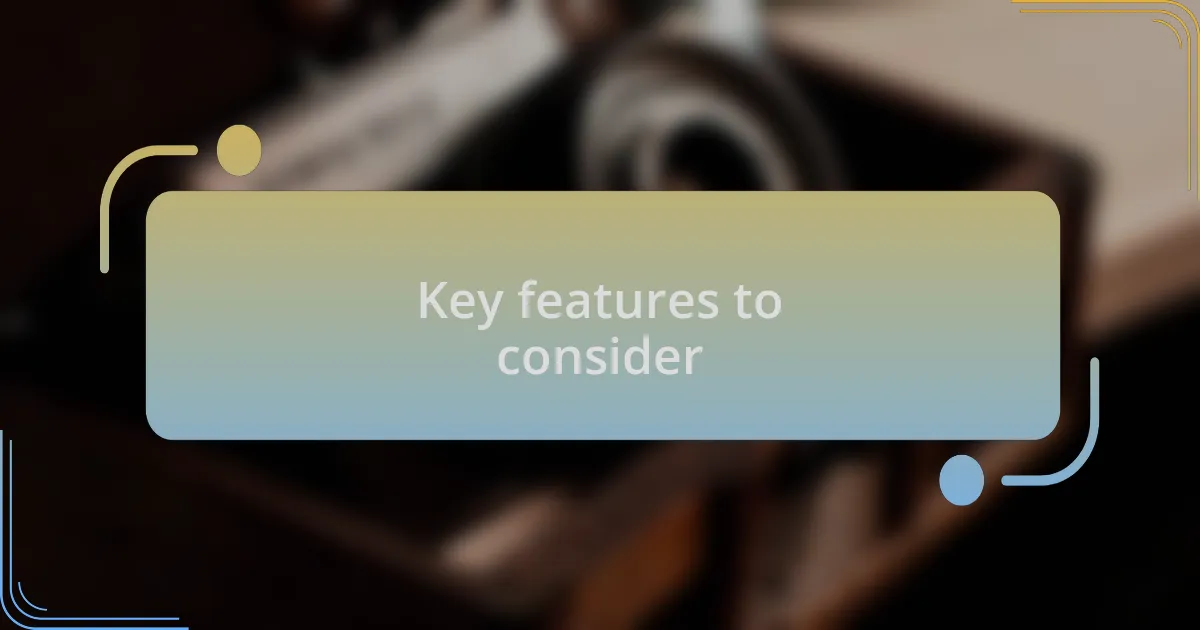
Key features to consider
When considering video lighting equipment, the quality of the light source is paramount. I learned this the hard way during a night shoot when I opted for a cheaper LED fixture that flickered just enough to ruin the entire scene. It’s a stark reminder that investing in high-quality lights can save a production from unnecessary headaches. Have you ever had to reshoot because of lighting issues?
Another essential feature to keep in mind is versatility. I often choose lights with adjustable settings that allow me to modify color temperature and intensity. I recall a project where we were shooting in a cafe; the ability to switch between warm and cool tones created the perfect ambiance to match our narrative. Flexibility in lighting setup can really elevate your storytelling, don’t you think?
Finally, portability is crucial, especially for on-location shoots. I always pack lightweight and compact lighting solutions, as lugging heavy gear around can become tiresome. I remember rushing through an outdoor scene with a simple, portable softbox; it made all the difference in maintaining efficiency while still achieving the look I wanted. Have you considered how much easier a shoot could be with gear that travels well?
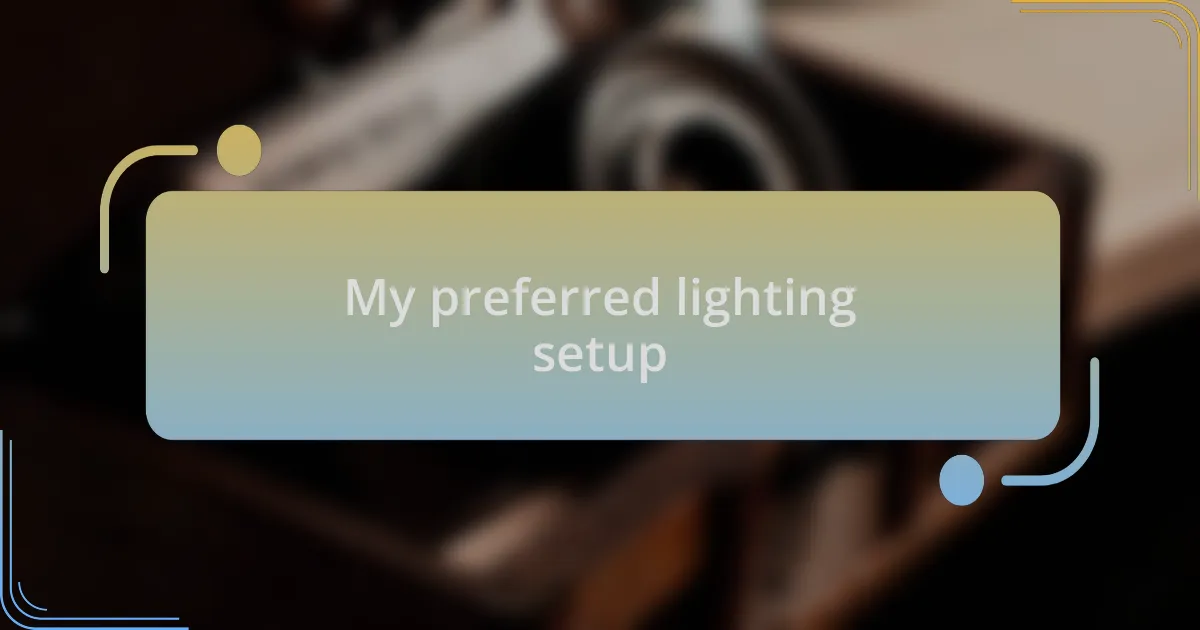
My preferred lighting setup
For my preferred lighting setup, I often lean towards a combination of softboxes and LED panels. During a recent documentary shoot, I used a softbox as the key light and a couple of LED panels for fill and backlight. The soft, diffused glow really enhanced the subjects’ features, creating a warm, inviting feel. Have you ever felt how a soft light can completely change the mood of a scene?
I can’t stress enough how crucial it is to include gels in your setup. I remember one project where I needed to counteract harsh overhead lighting. By using a simple blue gel, I transformed the sterile environment into a more cinematic blue hour setting. It added a layer of depth that brought the visuals to life. Isn’t it fascinating how a small adjustment can make such a significant impact?
Lastly, I always carry a powerful dimmer switch with me. On a recent shoot at sunset, adjusting the intensity of my lights allowed me to seamlessly blend artificial and natural light as the sun dipped below the horizon. This adaptability not only saved time but also helped maintain continuity in the footage. How often do you find yourself adjusting lighting on the fly to get that perfect shot?
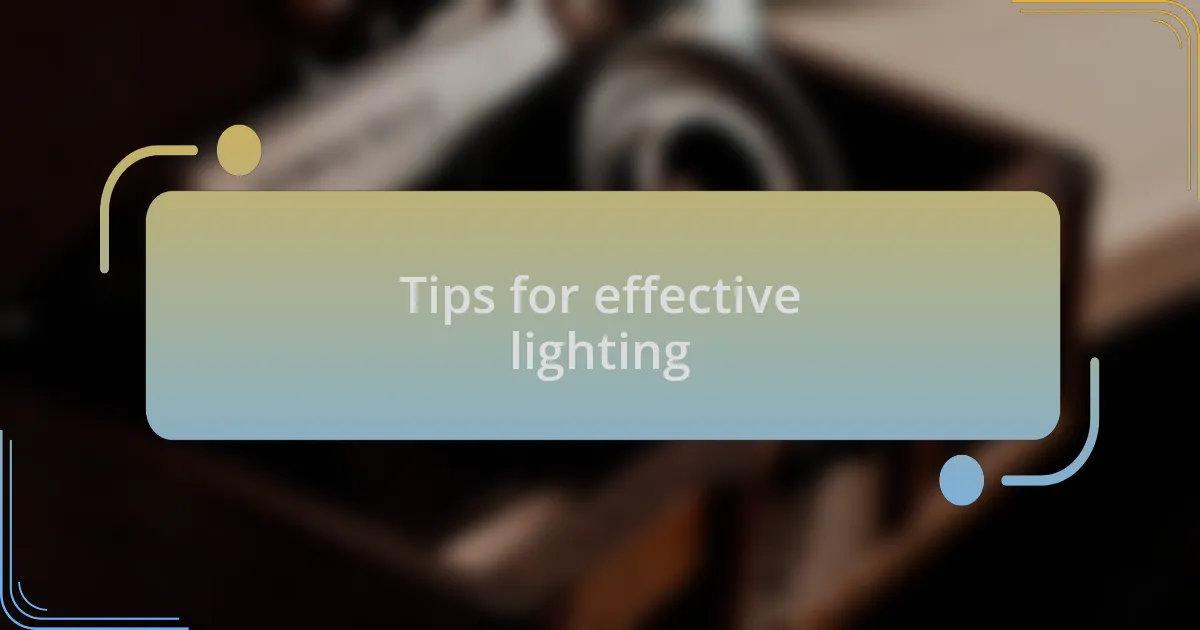
Tips for effective lighting
When it comes to effective lighting, the positioning of lights can dramatically alter the scene. I once shot a short film where I learned the hard way about the importance of angles. By placing a light slightly above and off to the side, I created shadows that added texture and drama to the character’s face. Have you ever considered how the slightest shift can transform your visuals from flat to dynamic?
Another tip I’ve learned is to be aware of your color temperature. Early in my film journey, I neglected this aspect, which resulted in inconsistent skin tones during editing. I always carry a color meter now; it’s become invaluable for ensuring that my lights blend harmoniously. Remember, the right color temperature can evoke feelings, so ask yourself: what mood are you trying to convey?
Finally, I believe it’s essential to experiment with practical lights in your frame. On a recent project, I used a lamp on desk in the background as an ambient light source, which not only warmed the scene but also made it feel lived-in. Practical lights can give your composition authenticity. Have you explored using such everyday objects to enhance your storytelling?